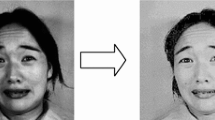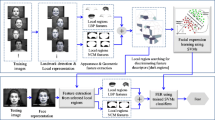Abstract
Traditional facial expression recognition methods often suffer from low feature dimension and low recognition rates. These methods typically extract features limited to commonly used image features, while overlooking the semantic information of facial expressions. In this paper, we proposed an innovative facial expression recognition method that incorporates a novel calculation method for facial landmark features. These features are combined with Histogram of Oriented Gradients (HOG) and wavelet features using weighted concatenation to form the final feature vector. Support Vector Machines (SVM) are employed for classification. The proposed method achieves an impressive accuracy of 93.4% on the JAFFE dataset.
Access this chapter
Tax calculation will be finalised at checkout
Purchases are for personal use only
Similar content being viewed by others
References
Li, S., Deng, W.: Deep facial expression recognition: a survey. IEEE Trans. Affect. Comput. 13(3), 1195–1215 (2022)
Mellouk, W., Handouzi, W.: Facial emotion recognition using deep learning: review and insights. Procedia Comput. Sci. 175, 689–694 (2020)
Zhang, J., Yin, Z., Chen, P., Nichele, S.: Emotion recognition using multi-modal data and machine learning techniques: a tutorial and review. Inf. Fus. 59, 103–126 (2020)
Lyons, M.J.: “Excavating AI” re-excavated: debunking a fallacious account of the JAFFE dataset. http://arxiv.org/abs/2107.13998 (2021)
Salcedo-Sanz, S., Rojo-Álvarez, J.L., Martínez-Ramón, M., Camps-Valls, G.: Support vector machines in engineering: an overview. Wiley Interdiscip. Rev. Data Min. Knowl. Discov. 4(3), 234–267 (2014)
Shan, C., Gong, S., McOwan, P.W.: Facial expression recognition based on local binary patterns: a comprehensive study. Image Vis. Comput. 27(6), 803–816 (2009)
Dalal, N., Triggs, B.: Histograms of oriented gradients for human detection. In: 2005 IEEE Computer Society Conference on Computer Vision and Pattern Recognition (CVPR 2005), San Diego, CA, USA, vol. 1, pp. 886–893. IEEE (2005)
Li, Z., Liu, F., Yang, W., Peng, S., Zhou, J.: A survey of convolutional neural networks: analysis, applications, and prospects. IEEE Trans. Neural Netw. Learn. Syst. 33, 6999–7019 (2022)
Simonyan, K., Zisserman, A.: Very deep convolutional networks for large-scale image recognition. http://arxiv.org/abs/1409.1556 (2015)
He, K., Zhang, X., Ren, S., Sun, J.: Deep residual learning for image recognition. In: 2016 IEEE Conference on Computer Vision and Pattern Recognition (CVPR), Las Vegas, NV, USA, pp. 770–778. IEEE (2016)
Szegedy, C., et al.: Going deeper with convolutions. In: 2015 IEEE Conference on Computer Vision and Pattern Recognition (CVPR), Boston, MA, USA, pp. 1–9. IEEE (2015)
Lucey, P., Cohn, J.F., Kanade, T., Saragih, J., Ambadar, Z., Matthews, I.: The extended Cohn-Kanade dataset (CK+): a complete dataset for action unit and emotion-specified expression. In: 2010 IEEE Computer Society Conference on Computer Vision and Pattern Recognition – Workshops, San Francisco, CA, USA, pp. 94–101. IEEE (2010)
Zahara, L., Musa, P., Wibowo, E.P., Karim, I., Musa, S.B.: The facial emotion recognition (FER-2013) dataset for prediction system of micro-expressions face using the convolutional neural network (CNN) algorithm based Raspberry Pi. In: 2020 Fifth International Conference on Informatics and Computing (ICIC), Gorontalo, Indonesia, pp. 1–9. IEEE (2020)
Doersch, C.: Tutorial on variational autoencoders. http://arxiv.org/abs/1606.05908 (2021)
Goodfellow, I., et al.: Generative adversarial networks. Commun. ACM 63(11), 139–144 (2020)
Yang, L., Tian, Y., Song, Y., Yang, N., Mam K., Xie, L.: A novel feature separation model exchange-GAN for facial expression recognition. Knowl. Based Syst. 204, 106217 (2020)
Liu, C., Wechsler, H.: Gabor feature based classification using the enhanced fisher linear discriminant model for face recognition. IEEE Trans. Image Process. Publ. IEEE Signal Process. Soc. 11(4), 467–476 (2002)
Qiao, Z., Zhang, Q., Dong, Y., Yang, J.-J.: Application of SVM based on genetic algorithm in classification of cataract fundus images. In: 2017 IEEE International Conference on Imaging Systems and Techniques (IST), Beijing, pp. 1–5. IEEE (2017)
Zhang, K., Zhang, Z., Li, Z., Qiao, Y.: Joint face detection and alignment using multitask cascaded convolutional networks. IEEE Signal Process. Lett. 23(10), 1499–1503 (2016)
Amos, B., Ludwiczuk, B., Satyanarayanan, M.: OpenFace: a general-purpose face recognition library with mobile applications. CMU Sch. Comput. Sci. 6(2), 1–20 (2016)
Huang, S.-C., Cheng, F.-C., Chiu, Y.-S.: Efficient contrast enhancement using adaptive gamma correction with weighting distribution. IEEE Trans. Image Process. 22(3), 1032–1041 (2013)
Lepik, Ü., Hein, H.: Haar wavelets. In: Lepik, Ü., Hein, H. (eds.) Haar Wavelets. Mathematical Engineering, pp. 7–20. Springer, Cham (2014). https://doi.org/10.1007/978-3-319-04295-4_2
Lee, D.T., Schachter, B.J.: Two algorithms for constructing a Delaunay triangulation. Int. J. Comput. Inf. Sci. 9(3), 219–242 (1980)
Soman, K., Sathiya, A., Suganthi, N.: Classification of stress of automobile drivers using radial basis function kernel support vector machine. In: International Conference on Information Communication and Embedded Systems (ICICES2014), Chennai, India, pp. 1–5. IEEE (2014)
Zhang, L., Wang, D., Chen, Y., Sun, H., Han, X.: Facial expression recognition based on GMRF and KNN algorithm. Comput. Appl. Softw. 37(10), 214–219 (2020). (in Chinese)
Minaee, S., Minaei, M., Abdolrashidi, A.: Deep-emotion: facial expression recognition using attentional convolutional network. Sensors 21(9), 3046 (2021)
Author information
Authors and Affiliations
Corresponding author
Editor information
Editors and Affiliations
Rights and permissions
Copyright information
© 2023 The Author(s), under exclusive license to Springer Nature Switzerland AG
About this paper
Cite this paper
Zhao, Zj., Jiao, My. (2023). Facial Expression Recognition Based on Fused Features and Support Vector Machine. In: Hassanien, A., Rizk, R.Y., Pamucar, D., Darwish, A., Chang, KC. (eds) Proceedings of the 9th International Conference on Advanced Intelligent Systems and Informatics 2023. AISI 2023. Lecture Notes on Data Engineering and Communications Technologies, vol 184. Springer, Cham. https://doi.org/10.1007/978-3-031-43247-7_45
Download citation
DOI: https://doi.org/10.1007/978-3-031-43247-7_45
Published:
Publisher Name: Springer, Cham
Print ISBN: 978-3-031-43246-0
Online ISBN: 978-3-031-43247-7
eBook Packages: Intelligent Technologies and RoboticsIntelligent Technologies and Robotics (R0)




